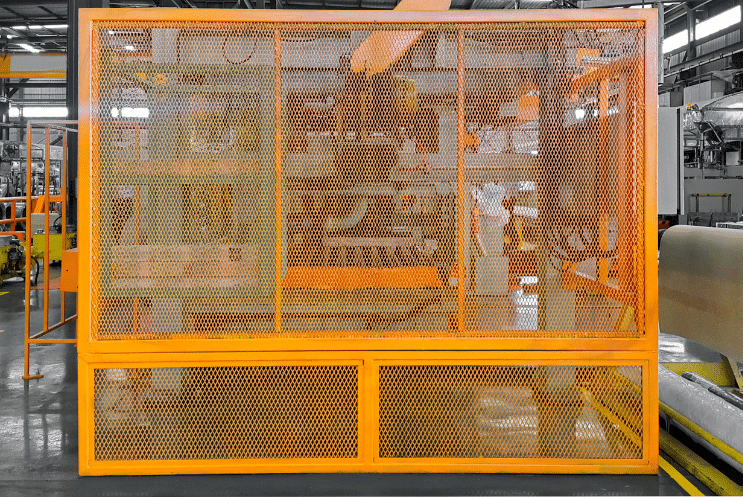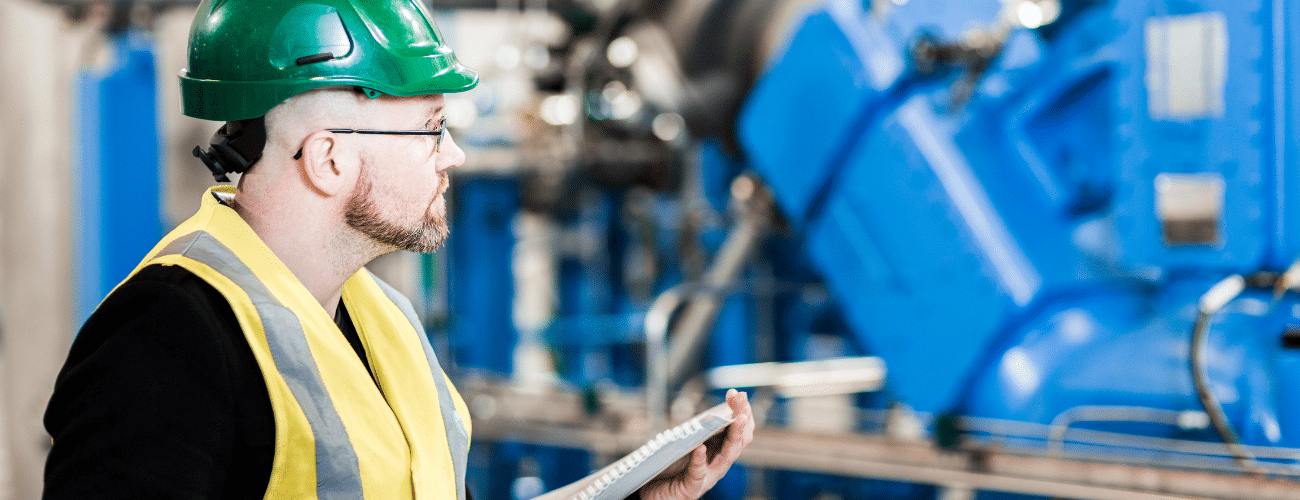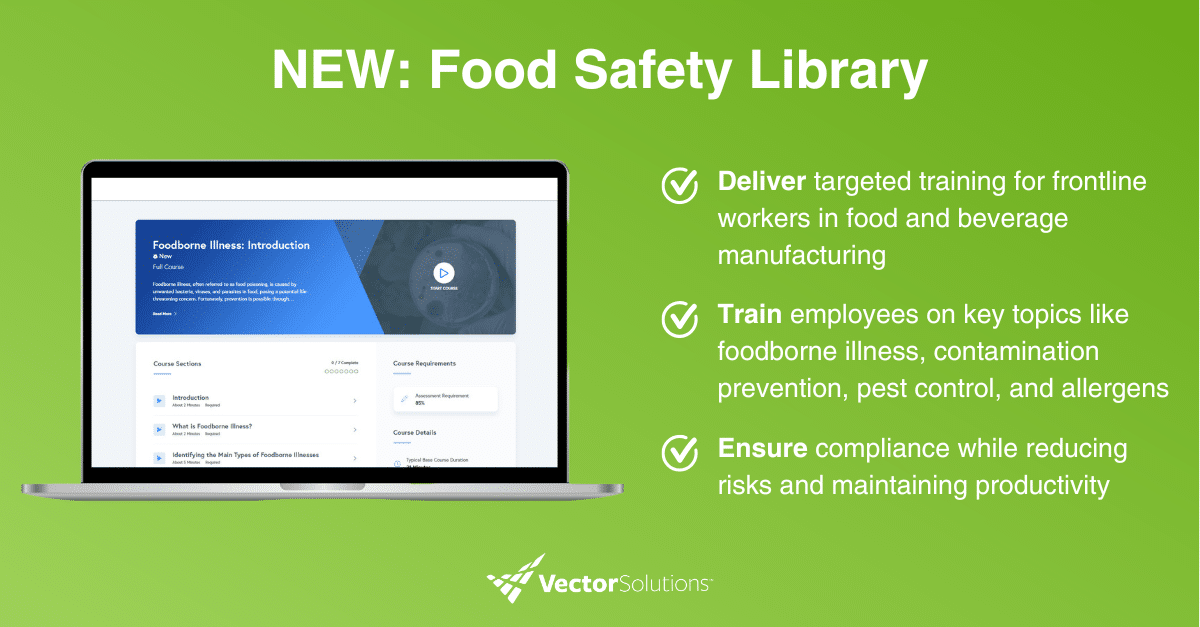September 27, 2024 7 min read

Machine Guarding Checklist
Industry:
Solution:

Machine guarding is essential for preventing workplace injuries related to machinery, but it’s not always performed correctly. In fact, OSHA publishes a list of the ten most cited standard violations every year and machine guarding makes the list. It’s essential that organizations learn to perform machine guarding properly. In this blog, we’ll provide a robust machine guarding checklist to promote safer practices in your company, comply with OSHA regulations, and avoid expensive fines. We’ll also provide resources to improve your machine guarding training in the workplace.
What is the OSHA Standard for Machine Guarding?
OSHA 1910.212 Subpart O requires that there be one or more methods of machine guarding affixed to machines. This is to protect the machine operator and other employees near the machine from hazards like rotating parts, flying chips and sparks, etc.
Examples of guarding methods include barrier guards, two-hand tripping devices, electronic safety devices, and so on.
Customizable Machine Guarding Checklist
A machine guarding checklist is a structured tool that guides the machine guarding process, ensuring that all essential safety protocols are covered.
Checklists are an efficient tool, but it’s also important to think of your organization’s specific safety needs. Use the checklist below as a starting point and then customize it as needed.
Machine Guarding Checklist: What Should My Machine Guarding Safeguard Do?
Your machine guarding safeguard should:
- Keep workers from contacting moving parts
- Be firmly secured and not easily removable
- Provide protection so falling parts can’t fall into moving parts
- Permit safe, comfortable, and relatively easy operation of the machine
- Include a system for shutting down machinery before the safeguards are removed
- Create no new hazards that weren’t there before
- Allow for easy lubrication of moving parts

Machine Guarding Checklist: Mechanical and Nonmechanical Hazards
There are various mechanical, nonmechanical, and electrical hazards to be aware of in relation to machine guarding. Ensure that your machine guarding does not include any of the following mechanical hazards:
- Evidence that the safeguards have been tampered with or removed
- Unguarded gears, sprockets, pulleys, or flywheels on the apparatus
- Exposed belts or chain drives
- Exposed set screws, key ways, collars, etc.
- Starting and stopping controls out of reach of the operator
- Lack of separate controls provided for multiple operators
- Lack of safeguards provided for all hazardous moving parts, including auxiliary parts
Nonmechanical hazards include:
- Lack of appropriate measures taken to protect against noise hazards
- Lack of special guards, enclosures, or personal protective equipment (PPE)
Electrical hazards include:
- Loose conduit fittings
- Non-properly grounded machinery
- Non-correctly fused and protected power supply
- Occasional minor shocks to employees during operations
Machine Guarding Checklist: What Training Should Workers Receive?
Be sure workers receive proper safety training, including:
- A description of all hazards associated with any machine they work with
- Explanations about the safeguards, the hazards they are intended to guard, and how they work
- How and why to use the safeguards
- How and when safeguards can be removed, and who can remove them (in most cases, this is just qualified maintenance and repair people following specific safe work practices)
- What to do if they discovered a safeguard is ineffective, damaged, or missing
Improve Your Machine Guarding Training
Online training is essential to improving workplace safety and productivity. Our comprehensive machine guarding training course provides a thorough overview of various topics, including:
- OSHA machinery guarding regulations
- Three main categories of machine guarding
- Common machine hazards
- Best practices for using and maintaining machine guards
This course is meant to be used as an introduction or refresher course for general industry workers who will be operating or working near industrial machinery, and it’s aligned with OSHA General Industry standards.
Machine Guarding Course
This course provides a thorough overview of machinery guarding regulations, common hazards, and best practices for using and maintaining machine guards.
View Course
Background Information on Machine Guarding
Before you begin filling out this checklist, let’s go over some basic machine guarding information that you should know. Make sure to review the following sections carefully and ensure that your workforce possesses the necessary knowledge and skill sets to proceed.
Basic Hazards and Hazard Control
Assessing potential risks is a crucial step to mastering safe machine guarding practices. There are three areas where dangerous moving parts must be guarded, including:
- Point of operation: This is where the “action” of the machine happens, such as where a press cuts metal.
- Power transmission apparatus: This is where the machine transmits energy to motion, such as the motors.
- Other moving parts: This includes every other part that moves in the machine.
Make sure to inspect these three areas for safety hazards on a machine to mitigate potential risks and consequences.
Types of Motions and Actions
It’s critical that you and your employees are well informed about the different types of motions and actions that make up a machine. Here are some potentially dangerous motions to look out for:
- Rotating: Movement in a circle.
- Reciprocating: Back and forth movement.
- Transversing: Movement in a straight line.
Similarly, ensure that your workforce is aware of these potentially dangerous actions:
- Cutting: By rotating, reciprocating, or transverse motion.
- Punching: When power is applied to one side, such as in stamping.
- Shearing: Powering a saw or knife to trim a side.
- Bending: When power is applied to draw or stamp metal.
Non-mechanical hazards to look out for include power sources, noises, hazardous fluids, and other dangerous substances.
Types of Machine Safeguards
OSHA provides a list of types of machine safeguards, which you can find here:
- Guards: including fixed, interlocked, adjustable, and self-adjusting.
- Devices: including presence-sensing, pullback, restraint, safety controls, and gates.
- Location/distance: hazards are reduced by locating a machine so that its hazardous areas are not typically accessible.
- Feeding and ejection methods: including automatic feed, semi-automatic feed, automatic ejection, semi-automatic ejection, and the use of robots.
- Additional aids: including awareness barriers, miscellaneous protective shields, and hand-feeling tools and holding fixtures.
The Hierarchy of Controls
The hierarchy of controls is a method used for creating solutions to workplace hazards. Organizations should try one type of control before trying another. In order, the types of controls to try are:
- Elimination or substitution: Either completely removing a hazard from the work environment or replacing it with a less hazardous alternative.
- Engineering controls: These reduce or prevent hazards from contacting workers, and machine guarding is a prime example.
- Work practice controls: These administrative controls define the methods used to perform a task to reduce potential hazards.
- Personal Protective Equipment (PPE): PPE is essential for safeguarding workers against injuries and health hazards in the workplace.
Isolation of Energy and Lockout/Tagout
Guards can be removed for maintenance and repair, but this can only be performed by specially trained maintenance personnel. In those cases, energy sources should be isolated, and the machine should be locked and tagged out.
When done properly before equipment service or maintenance, lockout/tagout procedures control hazardous energy and protect workers from harm. Here are the six basic steps of lockout/tagout:
- Preparation. The authorized employee must investigate and gain a complete understanding of all types of hazardous energy that might be controlled.
- Shutdown. Shut down the machine or equipment that will be serviced or maintained, ensuring to inform any affected employees.
- Isolation. Isolate the machine or equipment from any source of energy, which may include turning off power at a breaker or shutting a valve.
- Lockout/tagout. The authorized employee must attach lockout and/or tagout devices to each energy-isolating device.
- Stored energy check. Look for any hazardous energy that’s been “stored” within the machine, since any residual energy must be made non-hazardous.
- Isolation verification. An authorized employee must verify the machine has been properly isolated and de-energized.
To learn more, check out our comprehensive online training course on lockout/tagout procedures for affected employees.
Online Industrial and Manufacturing Training Courses
Our largest, most comprehensive training library for industrial manufacturing clients offers a range of industry-specific and skills-specific eLearning courses within one library.
View Courses
How Vector Solutions Helps with Workplace Safety Training
“I would say the biggest benefit the solution has helped us achieve is to remain on the leading edge of our industry as a firm of choice because we invest in the development of our people and practice.”
– Training and Development Manager
At Vector Solutions, we pride ourselves on providing companies with quality, engaging training solutions to improve workplace productivity and remain at the competitive edge of their industries.
With our comprehensive Learning Management System (LMS), you can combine unique online training management software functionalities to streamline assigning, tracking, and reporting, all of which will help with the implementation of your machine guarding checklist. Explore our solutions to ensure your workforce stays prepared, compliant, and protected.
Ready to get started? Request a demo and learn more today.








